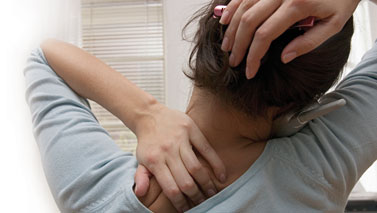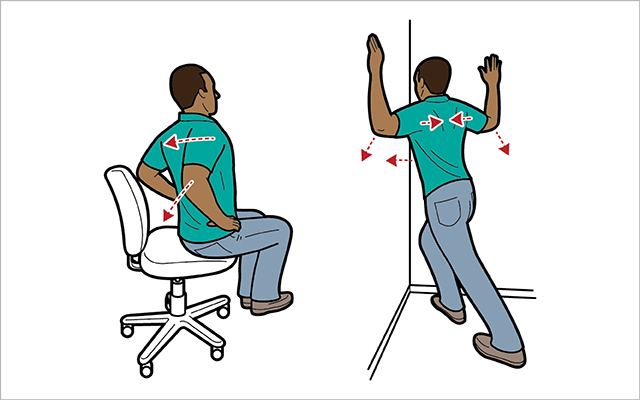Human bodies were never designed to sit at desks and operate computers. And they aren’t likely to get used to this arrangement any time soon. The trouble is, in offices and cubes around the world, the laws of physics and physiology are colliding – with some very undesirable results.
You know the drill: For every action, there’s a reaction. And nowhere is that principle truer than in your muscles, which work in pairs of “agonists” and “antagonists.” When a muscle (or group of muscles) shortens to move a joint, it’s acting as an agonist. The muscle on the opposite side of the joint stretches to allow the movement – it’s acting as an antagonist. When the joint is moved in the opposite direction, the roles switch.
To function optimally, these muscle buddies must be relatively equal in their strength and length. “Imbalances develop when you use one muscle group a lot more than its opposing muscle group,” says Marjorie King, PhD, assistant professor of athletic training at Plymouth State University in Plymouth, N.H.
That situation occurs often in our modern work world, and the muscle imbalances that result can contribute to various joint injuries, pain and dysfunction, all of which can throw off your fitness game in a big way.
Eric Cressey, CSCS, a strength and conditioning coach in Boston, Mass., who specializes in corrective exercise, says he’s never had a client with perfect muscle balance in all areas of the body. “True muscular balance is always a work in progress,” he says. Even for those with relatively good balance, there’s always room for improvement, Cressey notes, many people don’t realize that even a small imbalance can cause surprisingly big problems. Especially in those who repeat the same movements over and over – say, for eight to 10 hours a day.
Athletic activities can cause their own muscle imbalances, to be sure, especially if you don’t alternate your workouts between major muscle groups in the front and back of your body. But it turns out that more-sedentary activities, like sitting at a computer with your arms bent, can be major balance disrupters, too.
Office work is a prime culprit because the hip flexors and chest muscles are shortened and active, while the glutes and upper-back muscles are stretched and inactive. As a result, imbalances commonly develop between the hip flexors and their antagonists, the glutes, and also between the chest muscles and their antagonists, the upper-back muscles.
Unfortunately, it’s common to see scar-tissue adhesions develop on overly tight muscles, so you may need both soft-tissue work (like Rolfing or deep massage) and flexibility work (like yoga and stretching) to restore your muscles’ ideal length and quality. You’ll also require appropriate strength training to correct underlying imbalances.
The good news – you can get started here and now. By practicing the simple stretches and strengthening exercises below just three times a week, you’ll begin reversing the imbalances that are causing you trouble.
Tight Hip Flexors & Weak Glutes
- Cause: The hip flexors remain shortened and hyperactive during sitting. Over time, this becomes a chronic condition. Meanwhile, the muscles in the buttocks (the gluteus maximus, gluteus medias and gluteus minimus – collectively referred to as the glutes), remain stretched and inactive, eventually causing them to become weak and inhibited.
- Consequences: Tight hip flexors draw the pelvis forward, and weak glutes are unable to combat that forward pull, causing the low back to arch into a swayback position. “This causes compression of the discs of the lower spine,” says King, “which can lead to disc injuries and sciatica [pain or tingling that travels from the lower back down through the leg].”
- Assessment: Wearing your underclothes, stand sideways in front of a mirror. If your waistband tilts forward, you likely have tight hip flexors.
Corrections:
Strengthen with the Supine Bridge
- Lie face-up on the floor with your knees bent and your feet flat.
- Focus on drawing your belly button to your spine to activate the transverse abdominal muscle.
- Then lift your hips until your body forms a straight line from the base of your neck to your hips to your knees. Concentrate on contracting your glutes, not your hamstrings, to extend your hips to neutral.
- Hold the position for 10 seconds and then return to the starting position. Repeat six to 10 times.
See “BREAK IT DOWN: The Glute Bridge” for more.
Loosen with the Lunge Stretch
- Kneel on your right knee and place your left foot on the floor in front of your body so that your left knee bends at a 90-degree angle.
- Draw your navel toward your spine and roll your pelvis backward.
- Put your weight forward into the lunge until you feel a stretch in your right hip flexors (located where your thigh joins your pelvis). Be sure to keep your left knee in line with your left ankle.
- Hold the stretch for 20 seconds and then repeat on the other side.
See “BREAK IT DOWN: The Lunge” for more.
Tight Chest & Weak Upper Back
- Cause: Whether seated at a desk or in a car, we usually have our arms stretched out in front of us. This overuse of our chest muscles results in poor posture, a chronically tight chest, and a weak upper back and rear shoulders – a condition many gym-goers worsen by focusing more on the bench press than on upper-back exercises.
- Consequences: The muscles in the upper back and rear shoulders are important stabilizers. When these muscles are comparatively weak, the shoulders become unstable, especially when performing elevated arm movements such as swimming. As a result, King says, “This imbalance can cause shoulder pain and exacerbate carpal tunnel syndrome and cubital tunnel syndrome [pressure on the ulnar nerve (located behind the funny bone) that causes pain or tingling in the hand]. It’s also responsible for many of the rotator-cuff injuries that athletes experience.”
- Assessment: Stand with your arms hanging loosely at your sides. “The heel of your hand should fall even with the ball of your hip, and your palms should be facing your outer thighs,” says King. “But if your chest and the front of your shoulders are really tight, your hands will rest toward the front of your thighs, and your palms will face backward.”
Corrections:
Strengthen with the Seated Row
- Sit down at a seated-row pulley station and grasp the handles with both hands.
- Begin with your torso fully upright, abdominal muscles tightened (pull your belly button toward your spine) and your arms extended straight in front of you.
- First draw your shoulders downward, and then contract the muscles of your back (imagine squeezing a quarter between your shoulder blades) and pull the handles to your rib cage. Pause briefly, and slowly extend your arms again.
- Do 10 to 12 repetitions.
See “Fitness Fix: 2 Exercises to Fix a Slouched Posture” for more.
Loosen with the Chest Stretch
- While standing comfortably, use an overhand grip and place your hands about 3 feet apart along a length of resistance band or some other kind of elastic strap or cable.
- Inhale and lift both arms directly over your head.
- Without releasing your grip, exhale and carry the strap behind your back in a smooth arc, without bending your elbows. Stop when the strap is at roughly the height of your diaphragm. Reach as far behind you as possible. You should feel the stretch in your shoulders and chest.
- Hold for five seconds.
- Inhale and lift your arms back over your head. Exhale and return to the start position.
- Do this three more times.
This article originally appeared at “Office Imbalance.”



This Post Has 0 Comments